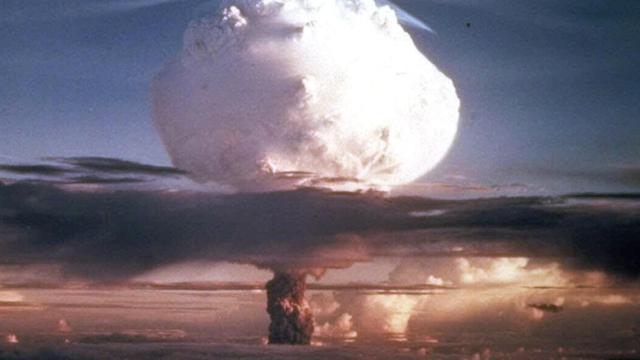Dismantling the world’s 15,000 nuclear weapons is one the most important geopolitical challenges humanity faces. That number seems bleak, given the current state of affairs. But if you wanted to dismantle just one warhead, here is what it would take.
A nuclear weapon is tested in the Marshall Islands in 1952. Photo credit AP
Those warheads make the world a dangerous place, but we have to keep in mind there were more than 70,000 nuclear warheads in existence at one point. Though Cold War-era non-proliferation treaties were central to the massive cuts, most nuclear warheads were retired or dismantled during the 1990s after the dissolution of the Soviet Union. President George H.W. Bush cut 9,500 during his term as president; in 1992 alone, he cut 5,300 warheads, which was the most by any president ever in history. During the 2000s, his son cut the stockpile by more than half to 5,270 warheads. Together, the son and dad president team cut 14,801 warheads from the stockpile.
Comparatively, President Barack Obama cut a mere 507 warheads, but relations between Russia and the U.S. were quite chilly during his term and both nations increasingly saw each other as military threats.
But the U.S. and Russia have their own arms issues. The New START treaty between the United States and Russia is the most important non-proliferation treaty in the world right now, yet its extension appears to be in limbo. India and Pakistan, though they only have 250 warheads between them, could ruin the earth’s atmosphere if they ever engaged in a regional nuclear conflict.
Politics aside, however, once a nation agrees to cut its nuclear stockpile, how does it happen, where and when? We spoke with a few nuclear weapons experts who walked us through the process of how this actually happens, with the focus on how the Americans do it.
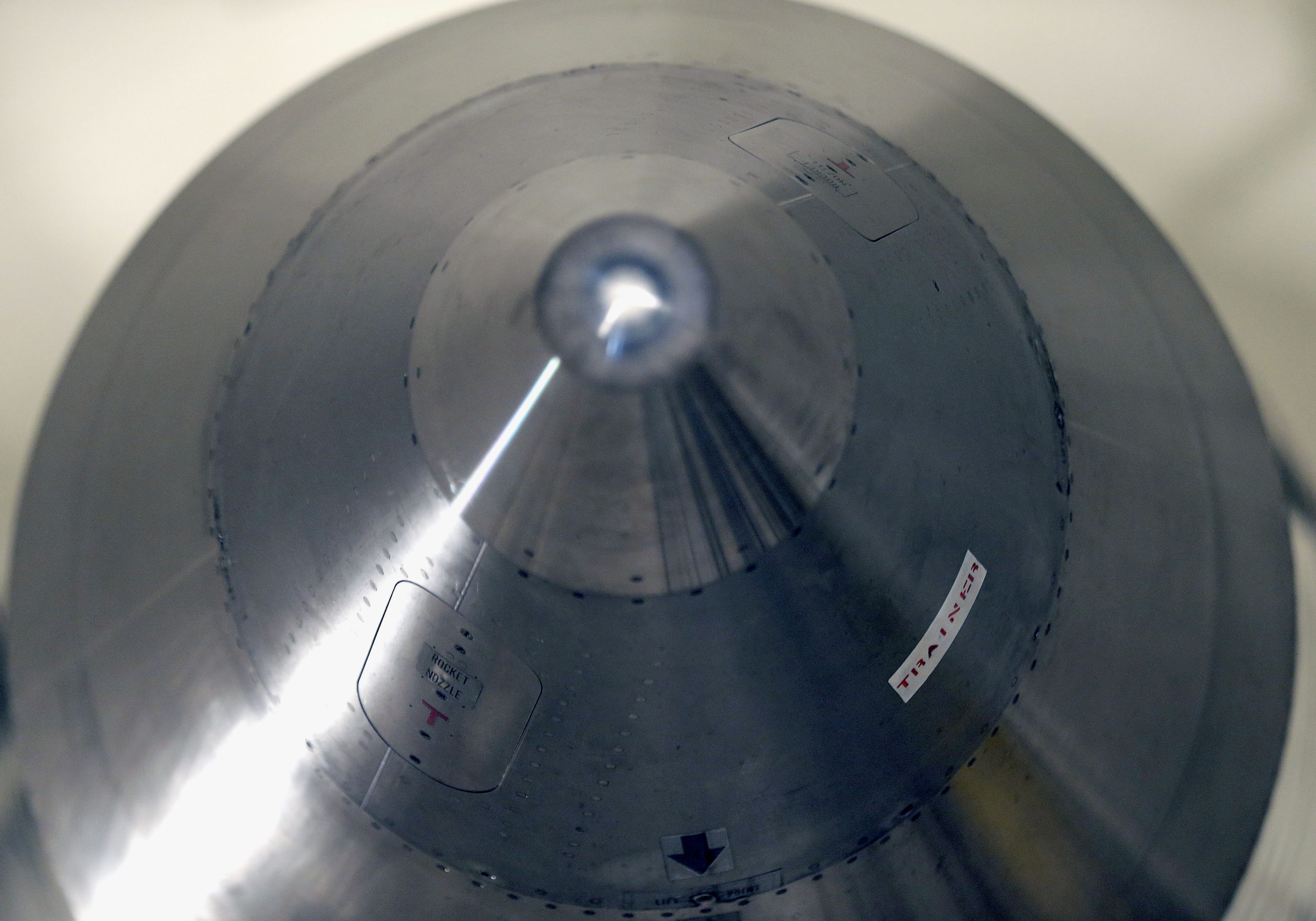
In this photo taken June 25, 2014, the warhead-containing nose cone of an inert Minuteman 3 missile is seen in a training launch tube at Minot Air Force Base, N.D. The base is tasked with maintaining 150 of the nuclear-tipped missiles spread out across the North Dakota countryside and keeping them ready to launch at a moment’s notice as part of the US’s nuclear defence strategy. (AP Photo/Charlie Riedel)
The Question Of Dismantlement Versus Retirement
Once a president decides to cut down the nuclear arsenal, he or she must decide if they want to retire or dismantle the warheads. It is important to know the difference. Tom Collina, Director of Policy at Ploughshares Fund — an anti-nuclear weapon philanthropic group — says that current treaties do not focus on the actual dismantlement of weapons.
“They only require that weapons be retired or removed from service,” he said. “They do not require that weapons be dismantled. So, you can have the New START treaty lowering the number of deployed systems you can have, but that doesn’t mean those weapons get dismantled. It just means they get put into storage.”
There is no verification process for determining if a nuclear warhead is destroyed or not once they get to storage, because they are simply are too small to see from space, Collina explains.
Missiles are different.
Those, along with bombers and submarines, are under treaty, and their dismantlement can be verified via satellite, simply because they’re so big. You can see a missile being chopped in half or a bomber’s wings clipped from space.
But a nuclear warhead itself, which is much smaller? That is simply not possible.
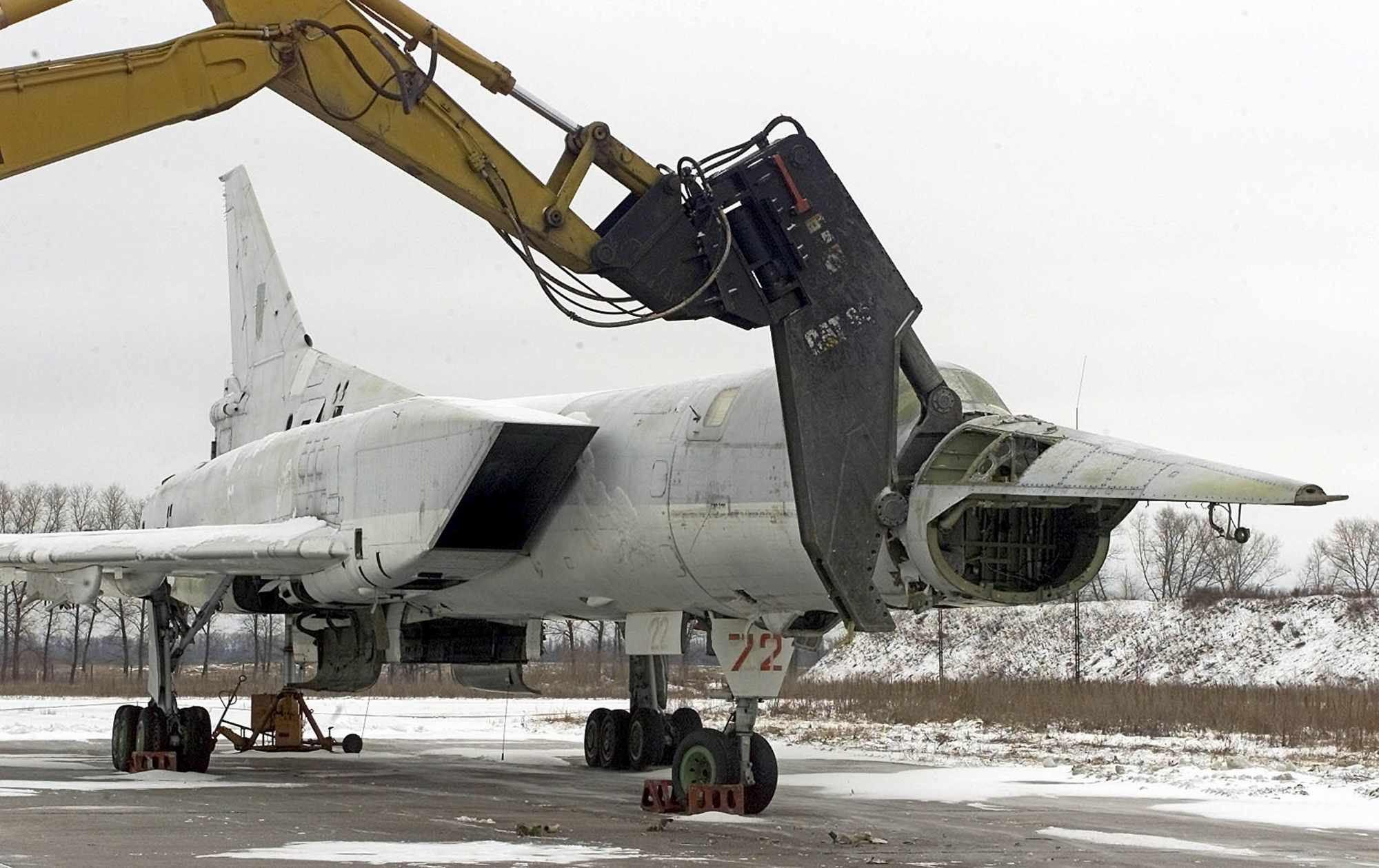
A modified excavator cuts off the nose of Tu-22MS Backfire bomber on Priluki airfield, some 200 km from the Ukrainian capital Kiev, in this Friday, Feb. 2, 2001, file photo. Ukraine is set to scrap the country’s last heavy bomber Friday in the central Poltava region, the Defence Ministry said. The dismantlement complies with the START I nuclear treaty and the Conventional Forces in Europe treaty, and is financed under the Heavy Bomber Elimination Program, a U.S. congressional initiative that has provided more than US$650 million (euro530 million) to Ukraine to scrap the country’s strategic nuclear arsenal. (AP Photo/Efrem Lukatsky)
Right now, there are around 2,800 warheads in retirement in the U.S., meaning they are no longer stockpiled. As the State Department explains, once a retired warhead is removed from its delivery platform, it is no longer useable and is not considered part of the nuclear stockpile. The tritium bottles are also removed. Tritium is a radioactive form of hydrogen that is critical to powering a bomb. Other “limited life components,” like the neutron generators, are also removed.
The warhead is stored in a depot where they hopefully will move on to the next process of being destroyed.
Separating A Warhead
The key components of a nuclear weapon, besides the metals used to construct its exterior, are uranium, plutonium, tritium boost gas, the neutron generator and other elements, according to the Union of Concerned Scientists. And separating a warhead is the hardest and most dangerous part of dismantlement.
The National Nuclear Security Administration is the governmental body that oversees the dismantlement process, which takes place at the Pantex Plant, in the Panhandle of Texas. Pantex is the primary plant where nuclear weapons assembly and disassembly occurs. The warhead is taken to an underground bunker, where its parts are separated.
Phillip Coyle, the Senior Science Fellow at the Center for Arms Control and Non-Proliferation, told me some of the valuable metals, such as the copper and gold, are recycled.
The toughest issue comes with the high explosive components, which are burned and the resulting ashes are shipped to an EPA-approved disposal site. Uranium-bearing components are separated and shipped to the Y-12 site at Oak Ridge, Tennessee. (We will get into what it takes to safely get rid of uranium later)
How Long Does The Dismantlement Process Take?
It depends.
Last year, the New York Times reported that the Obama Administration dismantled the fewest number of warheads since entering office in 2008. Obama, who was very vocal about cutting the number of nuclear weapons in the world, was criticised for his words not matching his actions; in 2015, only 109 weapons were dismantled.
But you can’t blame Obama entirely. In that same Times report, Hans M. Kristensen, director of the Nuclear Information Project at the Federation of American Scientists, is cited as saying that Obama had to contend with a Congress that clashed with his non-proliferation vision and negotiate with a difficult Kremlin:
“His vision of significant reductions and putting an end to Cold War thinking has been undercut by opposition ranging from Congress to the Kremlin,” Mr. Kristensen wrote. “An entrenched and almost ideologically-opposed Congress has fought his arms reduction vision every step of the way.”
Moscow, he added, has rejected cuts beyond modest ones it agreed to in the New Start treaty, which was signed in 2010 and observed beginning in 2011.
But once we get past the politics and everyone wants to destroy some nukes, how long does the technical process take? That, too, depends on a lot of things.
Let’s begin with workload. Coyle said a wide range of factors can determine how long it takes to dismantle one warhead, such as allocated funds, and the time it takes to do safety inspections. Even the number of lightening strikes in the area are considered. All of these issues determine how many warheads are destroyed at a given time.
“It has been more typical for 300 or so dismantlements to be completed each year,” Coyle said. “If, say, Pantex completed 365 dismantlements in a year, the average time for each dismantlement would be one day. If, say, Pantex completed about 120 dismantlements in a year that would be an average of about three days per dismantlement.”
FYI: the highest number of dismantlements between 1994 and 2015 took place during the 1990s, when Clinton was president. In 1995, 1,393 weapons were dismantled. On average, 1000 weapons were dismantled per year during the 1990s. Since 1999, that yearly average dropped to 300.
The Difference Between Uranium And Plutonium
Both uranium and plutonium can be used to make weapons, but one of the main differences is that you need a much smaller amount of latter, which is why some nuclear states prefer it.
Bomb-ready uranium is relatively easy to extract. The easiest way to make a uranium bomb is with U-235, which is a rare naturally occurring isotope of uranium. It’s usually mixed in trace amounts with the more common isotope of uranium, U-238. To extract what little U-235 there is, uranium needs to be “enriched,” most commonly by spinning it in massive centrifuge assemblies that are capable of separating the uranium by weight.
Enriching U-235 to 90 per cent or more makes it ready for weapons use.
Plutonium, on the other hand, is manmade and doesn’t naturally occur like uranium. Plutonium-239 is the isotope most commonly used in plutonium-based nuclear warheads.
“When you take a fuel rod that has uranium in it and put it in a reactor, some of the uranium burns,” David Wright, a nuclear weapons expert at the Union of Concerned Scientists said. “You put the uranium fuel rod [in the reactor], let the reactor operate for a few years. You pull it out, that fuel rod has plutonium in it. The way people get it is that they chemically break down the fuel rod and extract the plutonium.”
The downside is plutonium can’t be used for much else besides nuclear weapons.
What To Do With The Uranium
When compared to the process of getting rid of plutonium, it is relatively easy to break down uranium for peaceful use. Uranium is used in civilian nuclear power plants, but the kind that is used for nuclear weapons is highly enriched. You basically have to mix it with a lower grade of uranium (more specifically, reactor grade uranium, which is only three to five per cent U-235, as opposed to the 90 per cent in bombs) to make it ready for civilian use.
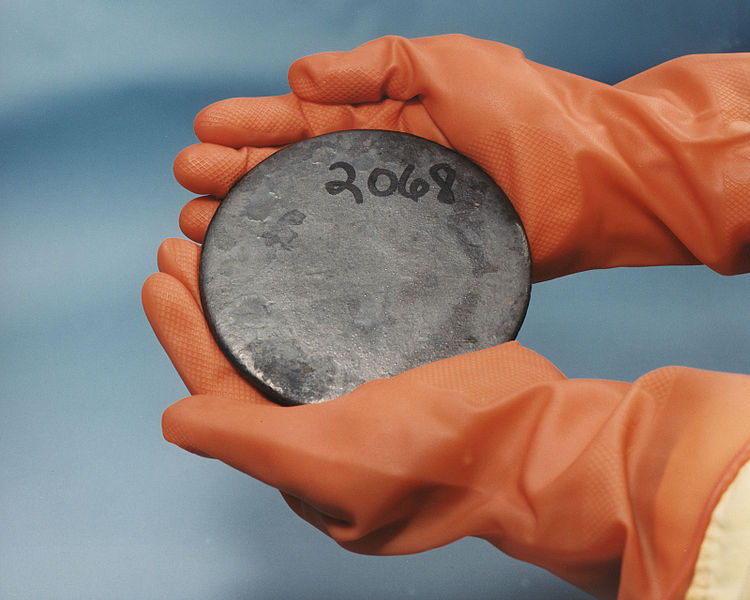
Highly-enriched Uranium (Wikimedia Commons)
Here’s a fun fact: Most Americans have no idea that nearly half of the uranium burned at U.S. power plants between 1994 and 2014 came from decommissioned Russian weapons, according to the Bulletin of Atomic Scientists. It started back in 1993 under the “Megatons to Megawatts” program, when the Russians agreed to convert 500 tons of bomb-grade uranium into nuclear power and sell it to the Americans; in turn the Americans sold to to energy companies stateside. It was a good way for Washington to find common ground with its former adversaries after the fall of the USSR.
Plus, it was profitable for them because the Russian economy was on the brink of collapse at several points during the 1990s. Moscow made $US17 ($23) billion during the program’s 20-year span. But the Kremlin ended it in 2013, as it didn’t feel Russia could benefit from it any longer. Specifically, Pavel Podvig, a Russian physicist, wrote in 2008 that the program is not economically advantageous for Russia, nor does it adequately address its own non-proliferation needs.
That said, weapons-grade uranium can be used for civilian use. Plutonium, though, is another story altogether.
Getting Rid Of Plutonium Is Harder
For one, there is no civilian use for plutonium in the United States because you can’t break it down or blend it. In other words, it is always ready to be used for weapons. In fact, according to Live Science, of its five common isotopes, only plutonium-238 and plutonium-239 are used for anything.
Pu-238 is used for powering space probes and Pu-239, the isotope we’re talking about, goes through a fission chain reaction when concentrated enough. And when that process takes place, it is nuke-ready.
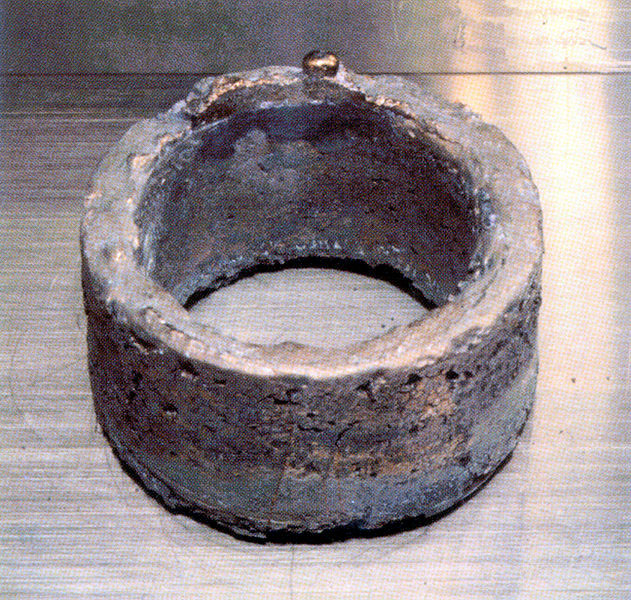
A ring of 99.96% pure electro-refined plutonium (Los Alamos National Laboratory)
By the way, Plutonium is pretty damn radioactive and contains the “worst kind of fission byproducts that could enter the environment as a result of the Fukushima nuclear disaster,” as Live Science notes (emphasis ours):
According to the Environmental Protection Agency, plutonium enters the bloodstream via the lungs, then moves throughout the body and into the bones, liver, and other organs. It generally stays in those places for decades, subjecting surrounding organs and tissues to a continual bombardment of alpha radiation and greatly increasing the risk of cancer, especially lung cancer, liver cancer and bone sarcoma.
There are documented cases of workers at nuclear weapons facilities dying within days of experiencing brief accidental exposure to plutonium, according to the Hazardous Substances Data Bank.
Furthermore, among all the bad things coming out of Fukushima, plutonium will stay in the environment the longest. One isotope of plutonium, Pu-239, has a half-life of 24,100 years; that’s the time it will take for half of the stuff to radioactively decay. Radioactive contaminants are dangerous for 10 to 20 times the length of their half-lives, meaning that dangerous plutonium released to the environment today will stick around for the next half a million years.
That is why Japan’s reported goal to use plutonium for civilian reactors have the U.S. and China worried. At one point, Japan had around 10 tons of unseparated plutonium in-country; 37.1 tons are in France and the United Kingdom. China fears Toyko could possibly use the plutonium to develop nuclear weapons, although the Japanese did give up 331kg of it in 2016.
Collina said it’s a good thing the U.S. has no plans to use plutonium for civilian purposes.
“You can’t blend down plutonium,” he says. “It’s always weapons-usable. So if you use this stuff at nuclear power plants, you’re basically spreading weapons-usable nuclear material all around. It’s a proliferation problem because we don’t want to set the example for other nations to say, ‘I’m going to use plutonium in my civilian power program’ and therefore create a cover for a secret weapons program. We want to have a pretty clear line that says, ‘Plutonium is only used for weapons and you should not use plutonium if you’re not using it for weapons.’”
As for actually getting rid of plutonium, the process is not environmentally friendly and it never will be. Most of the plutonium that is separated from nukes is stored at the Savannah River Site (SRS), near the Georgia border. Plutonium is also stored at the Pantex Plant. It’s authorised to store 20,000 plutonium pits; current estimates find that 14,000 are stored in the facility.
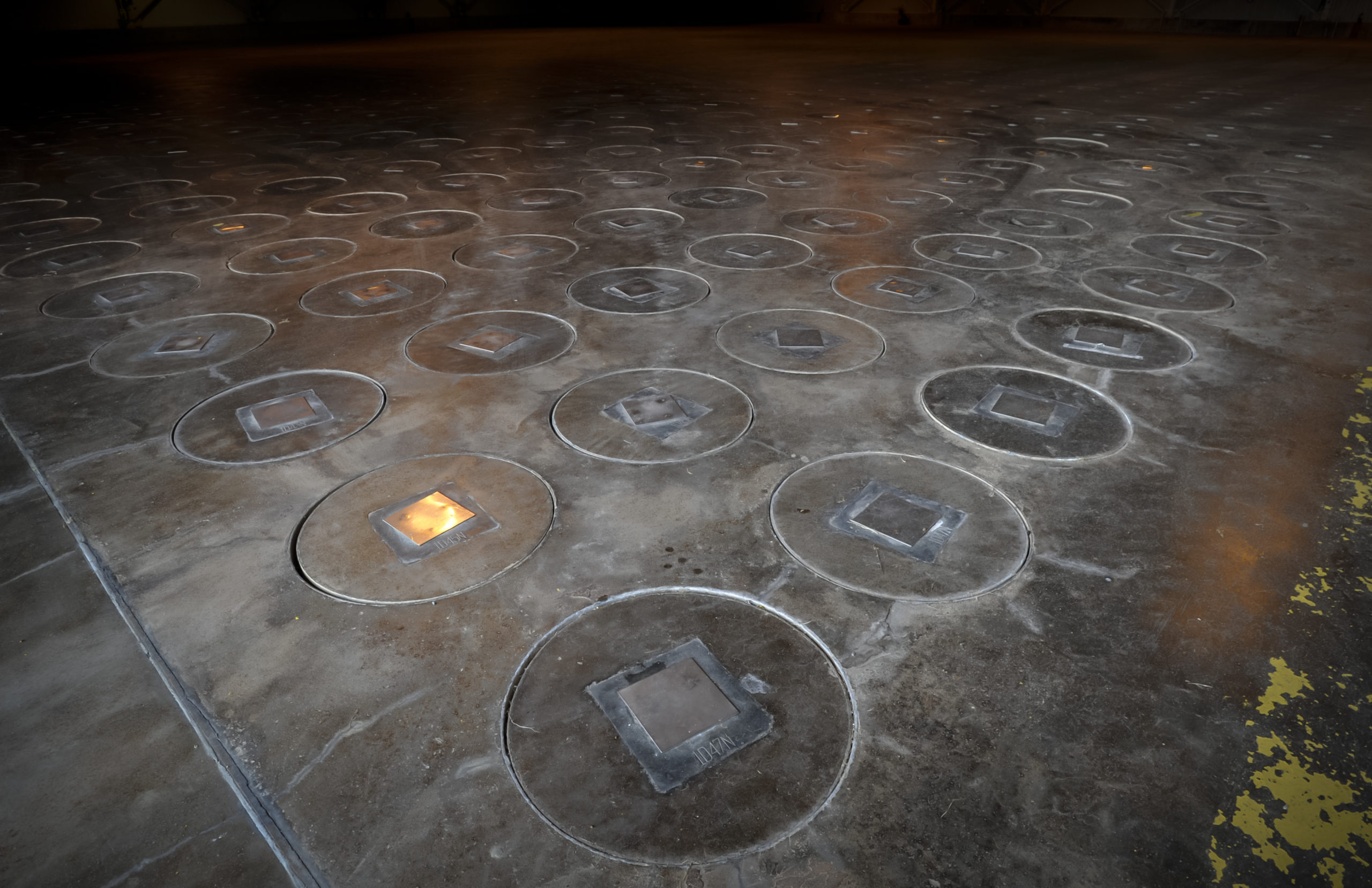
In this Nov., 20, 2013 photo, After radioactive waste is vitrified and sealed in large stainless steel canisters they are stored under a five-feet of concrete in a glass waste storage building at the Savannah River Site near Aiken, S.C. The glass waste storage buildings can hold more than 2,000 canisters. (AP Photo/Stephen B. Morton)
But here’s the catch: you can never make it truly safe, and no one wants it near them. For example, the Department of Energy, through the Nuclear Regulatory Commission, is currently overseeing construction of a facility at SRS to make MOX fuel from weapons-ready plutonium. It would then be used for commercial use.
The problem is that no one wants plutonium storage facilities in their backyards. The American ambassador to the United Nations, Nikki Haley, expressed concerns over the MOX fuel initiative when she was governor of South Carolina. Her issue was that the feds were supposed to remove a ton of plutonium from the state by January 2016 and ship it to another facility in New Mexico or process it for commercial use through the facility; neither happened, so she sued the Department of Energy. A federal circuit court dismissed the case.
Officially, MOX fuel is not being used in the United States, according to the Nuclear Regulatory Commission. Europe uses MOX fuel, but its plutonium is from spent nuclear fuel rather than nuclear weapons.
Former Nevada Senator Harry Reid resisted the Yucca Mountain Nuclear Waste Repository project, which was supposed to be a deep geological repository storage facility for spent nuclear fuel and radioactive waste like Pu-239. Under the Nuclear Waste Policy Act amendments of 1987, the Yucca Mountains were supposed to be the key destination for storing this waste, but Reid worked with Obama to end funding for the project.
Where To Send It?
So, if no one wants plutonium in their backyard here on planet earth, where can it be disposed? Well, there have been a bunch of wild ideas, like blasting it into the sun. Which, as the video below explains, is a pretty bad idea.
You also have to factor in the possibility the space ship won’t make it to orbit. “Space shuttles crash,” Collina said. “So if you had just one crash with a space shuttle full of plutonium, that would ruin your whole day.”
The best plan of action the feds have to deal with weapons-ready plutonium is to simply store it someplace — a place where folks won’t complain to much about it. Good luck finding such a place.
How Much Does It Cost To Build A Warhead Versus Dismantling It?
This is not an easy question to answer, because the government doesn’t make it easy for us to know. But the costs associated with a nuclear weapon deal mainly with the warhead and the delivery system. According to the Union of Concerned Scientists, the United States hasn’t built warheads since the 1990s, but it is refurbishing several types to extend their shelf life.
The cost for the Department of Energy to extend the life of 2,000 submarine-based W76 warheads cost of roughly $US2 ($3) million each. The B61 bomb will be more costly, it will require more modifications. For 400 or 500 B61 bombs, costs total around $US10 ($13) billion or $US20 ($27) million each.
“Compared with the cost of designing, manufacturing, and deploying nuclear weapons, and the cost of nuclear weapon delivery systems, the process for dismantling nuclear warheads is not particularly expensive,” Coyle said. “Whether a dismantlement takes on average one day or three days, that is a very small part of the time and cost of building and deploying nuclear weapons in the first place.”
Dismantling of all of the world’s nuclear weapons is indeed a goal most sober-minded policy makers and non-proliferation advocates strive for. But doing so requires navigating complex global politics, galvanizing legislative will, easing local community concerns and mastering the science of getting rid of the nuclear waste separated from the warhead.
Of course, there is a great way to avoid all of these issues in the future altogether.
“Better that the material not be produced in the first place,” Collina said. “But it’s too late for that.”
